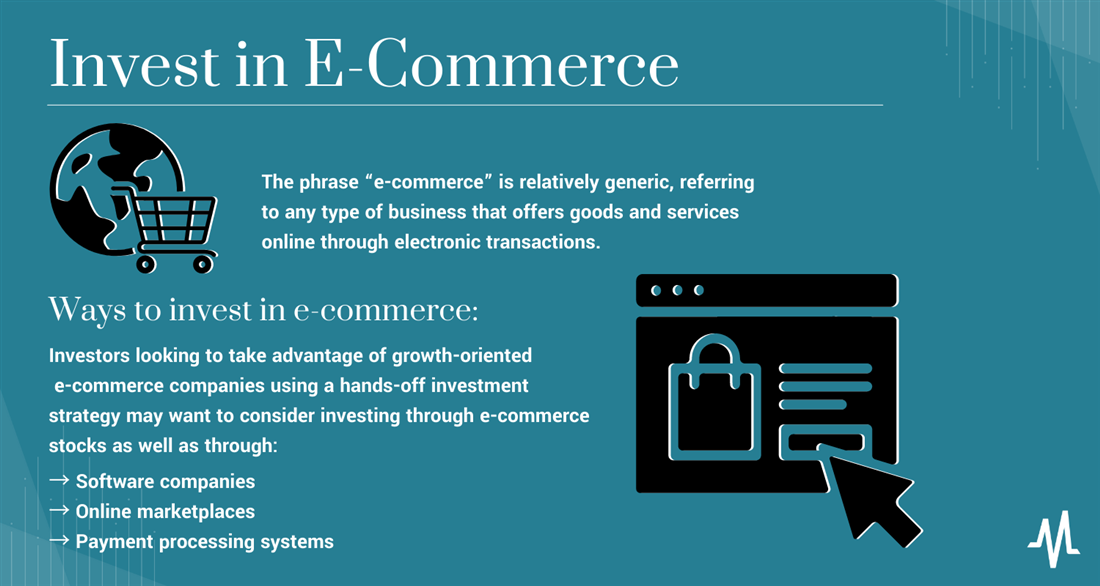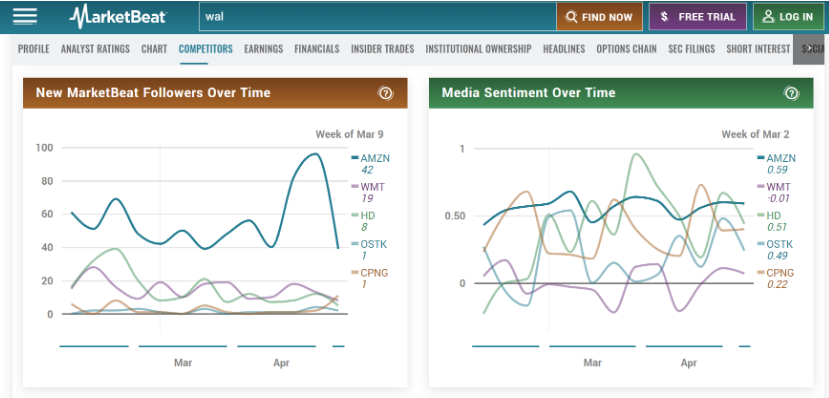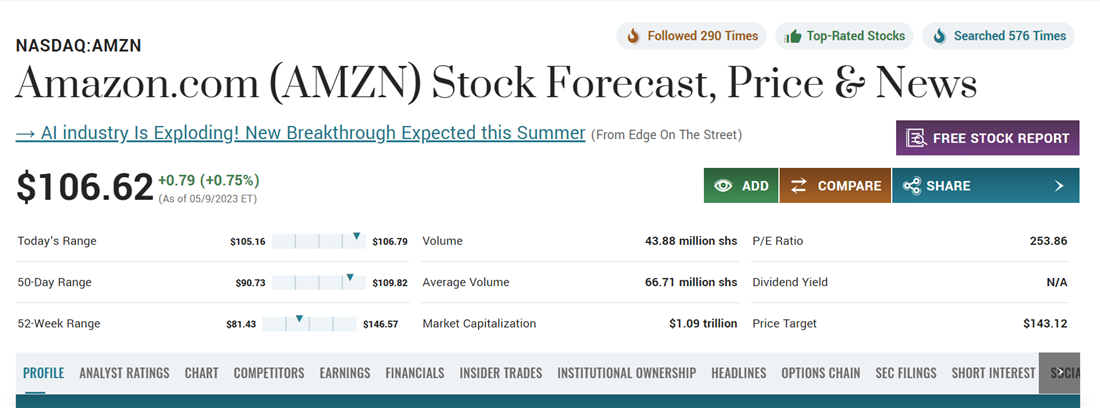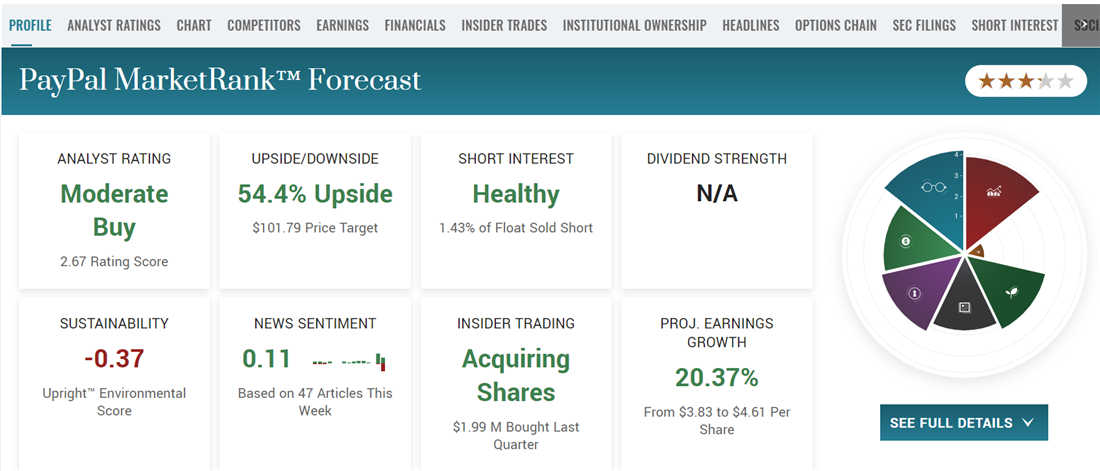It's now easier than ever to explore online products available for resale, and numerous stocks trading on major exchanges can provide exposure to the e-commerce sphere. Read on to learn more about the basics of e-commerce, how it works, the major players in the industry and how to invest in ecommerce business opportunities.
Basics of the E-Commerce Industry
The phrase "e-commerce" is relatively generic, referring to any business offering goods and services online through electronic transactions. While e-commerce investment opportunities came to the forefront during the COVID-19 pandemic, e-commerce now represents a major part of the retail sector of the United States.
About 14.6% of retail purchases occurred online in 2022, surpassing more than 20% in 2023. E-commerce purchases should grow by an additional 11% globally through 2027.

Ways to Invest in E-Commerce
Investors looking to take advantage of growth-oriented e-commerce companies using a hands-off investment strategy may consider investing in e-commerce stocks. E-commerce stocks are shares of companies in the online retail sector — incorporating multiple e-commerce investments into your portfolio can enhance your sector exposure. Check out three of the largest types of businesses in the e-commerce sphere in the next section.
Software Companies
Software companies are the backbone of the e-commerce industry, empowering small business owners with the tools and tech they need to compete against larger online retailers. For example, online commerce service companies like Shopify (NYSE: SHOP) provide straightforward website and online store creation tools that require no technical knowledge. In exchange, these companies charge a one-time or monthly service fee. Other major software companies with e-commerce operations include Wix.com (NASDAQ: WIX) and Salesforce (NYSE: CRM).

Image: Shopify and competitors like NetEase (NASDAQ: NTES) and Cadence Design Systems (NASDAQ: CDNS) have seen fluctuating media sentiment over time.
Online Marketplaces
If you're like most consumers, you're probably most familiar with e-commerce through online marketplaces. These companies provide a platform for buyers and sellers to buy and sell products and services through their e-commerce business. A common e-commerce model is to purchase products through a third-party seller and offer them to a wider audience on a major online marketplace like eBay (NASDAQ: EBAY). Other e-commerce giants include Amazon.com (NASDAQ: AMZN) and Etsy (NASDAQ: ETSY).

Image: With a total market capitalization of over $1 trillion, Amazon.com is one of the world's largest e-commerce businesses.
Payment Processing Systems
Shopping online requires consumers to use a payment method other than check or cash — and in many cases, consumers may not feel comfortable entering their credit card information directly into e-commerce sites. Payment processors facilitate online transactions by securely processing electronic payments between customers and businesses without jeopardizing the customer's financial data.
Payment processors like PayPal Holdings (NASDAQ: PYPL) use high-level encryption and data management services to connect small businesses with online consumer shopping. These companies are a crucial part of the e-commerce industry, providing a convenient and affordable way for business owners to collect payments.

Image text: Analyst ratings of payment processing companies like PayPal have mainly been positive since the COVID-19 pandemic.
Example of an E-Commerce Business
As an e-commerce business, Amazon.com has revolutionized how consumers shop, disrupting traditional retail business models. As a result, investors over the years who have bought into Amazon.com have seen consistent returns and growth — and opportunities may still be available.
In May of 2023, Amazon.com was ranked as a "moderate buy" by investment analysts, with a projected price about 30% above the market rate. Even as consumers return to in-person shopping, Amazon.com has remained a powerhouse, barreling to more than $1 trillion in market capitalization. The company has also remained consistent in outranking competitors like Walmart (NYSE: WMT) and Overstock.com (NASDAQ: OSTK), a testament to its continuous innovation.
How to Start Your Own E-Commerce Business
While it's easy to invest in an ecommerce business by purchasing shares of stock, some investors prefer to take a more direct role in their e-commerce opportunity by opening their own business. Opening an e-commerce store is a popular method of creating passive income, and tools like Shopify have streamlined the process of direct sales. Here's how to get started with e-commerce.
Step 1: Choose a product.
The first step to opening an e-commerce business is to decide what to sell, often the most challenging part of starting e-commerce, as many sectors are heavily saturated.
Before choosing a product, research the market to identify trends and popular products. Look for products with high demand but low competition, and choose a product that fits directly into a specific niche but still stands out. For example, if you're interested in opening a makeup e-commerce business, you might select products with distinctive shades or packaging that looks great on camera. This will improve your marketing efforts and make standing out in your niche easier.
Step 2: Design your website.
After you've identified a product that you think will work well with your niche and target market, it's time to design a complementary online store. The best platform to use might vary depending on your level of technical skill. While those with coding experience can set up their own purchasing system using standard hosting options like GoDaddy, anyone can use choices like Shopify and WooCommerce to set up a store.
The platform you choose will determine the design process. Most e-commerce development sites use simple drag-and-drop interfaces that allow those without previous experience to create a unique web store. While the website's design should be appealing, make sure that it is also professional, with clearly marked checkout and contact points. Once your store is online, place a test order to ensure everything is easy-to-use and intuitive.
Step 3: Select a shipping strategy.
When the design portion of opening your business is complete, you must create a plan to get your business to consumers. Your shipping strategy will directly affect customer satisfaction, so it's essential to consider multiple methods. E-commerce companies have various options for shipping products, but the following three models are the most common.
- Direct carrier: If you physically hold or create the products you're selling, you can use carriers like FedEx and USPS to ship products directly. This method is the most labor-intensive but offers the most direct control over product movements.
- Fulfillment center: Fulfillment centers are third-party facilities that store, pick, pack and ship your products for you. These businesses can help you streamline your shipping process and reduce shipping times and costs, especially if you need to hold large product volumes.
- Dropshipping: Dropshipping is a method of working directly with your product seller, shifting the responsibility of shipping to the manufacturer. As the e-commerce business owner, you act as an intermediary between your customer and the products. While this is the most convenient for business owners, it can lead to frustration with shipping times and damage.
When choosing a shipping method, consider factors such as shipping costs, delivery times, package sizes, shipping volume and the type of products you sell. Communicate your shipping policies clearly to your customers to avoid confusion and manage their expectations.
Step 4: Create a marketing strategy and launch your business.
Test your entire shipping supply chain at least once before launching your website. Social media platforms like Facebook and TikTok provide free channels to advertise your products to the public. Put your marketing strategy, and be sure to audit shipping times and services after getting your first few orders.
Benefits of Investing in E-Commerce
Thanks to its convenience, the e-commerce industry has become more popular with consumers, which may make it appealing to growth investors.
- High growth potential: E-commerce is a rapidly growing industry, with online sales expected to continue rising as the global economy becomes more interconnected. This growth-oriented nature can present opportunities to investors.
- Low overhead costs: Compared to traditional brick-and-mortar stores, e-commerce businesses generally have lower overhead costs and spend less on staffing costs and commercial rent. This can lead to higher profit margins, making it appealing for both stock and direct investments.
Risks of Investing in E-Commerce
Like healthcare, automotive and any other industry, investing in e-commerce comes with unique risks investors should be aware of.
- Cybersecurity concerns: The virtual payment networks needed for online shopping make e-commerce businesses vulnerable to cyberattacks. Crimes like data breaches and hacks can lead to lawsuits and damage a company's reputation, leading to sharp losses.
- Supply chain demands: E-commerce businesses rely on suppliers and manufacturers to provide products. Supply chain disruptions, such as natural disasters or labor disputes, can result in product shortages and lost revenue.
Future of Investing in E-Commerce
The e-commerce industry is constantly evolving, and several trends should shape the industry in the coming years. Artificial intelligence (AI) is seeing a wave of innovation in most industries, and e-commerce is no different. From chatbots that provide customer service to personalized product recommendations, AI should become more sophisticated and integrated into e-commerce operations.
Another key trend introduced in 2022 is using social media networks as a sales platform. While influencer marketing has been disrupting traditional advertising channels for over a decade, social media platforms have begun introducing e-commerce components, partnering with users to drive sales. Shoppable posts and in-app buying experiences will mean that e-commerce companies must stay dynamic on social media, connecting where users spend their time.
Investing in E-Commerce
If you're an investor considering a direct-sales method of getting involved in e-commerce, it's important to audit your business processes regularly. Just like investors are encouraged to rebalance their portfolios as their investing timelines and goals change, business owners should scale their operations as needs change. Working directly with a third-party shipping service or warehouse can improve both returns and customer relations.
FAQs
Learn the answers to a few final questions about e-commerce below.
How do you invest in e-commerce?
You can invest in e-commerce by purchasing shares of stock issued by companies involved in e-commerce operations. Large e-commerce companies include Amazon.com and Walmart. You can also invest in e-commerce on a smaller scale by opening a dropshipping or self-managed company.
Is e-commerce really profitable?
E-commerce businesses can be highly profitable, especially when you take a lower financial barrier to entry compared to traditional business models. However, the sphere is also highly competitive, which leads many businesses to fail. Be sure to evaluate products and e-commerce opportunities individually before investing.
How much do I need to invest in e-commerce?
The amount of money you need to invest in e-commerce can vary depending on your business model, product offerings and marketing strategy. However, you can start e-commerce with relatively low capital investments compared to traditional businesses. You can start some types of businesses with as little as $100 in startup costs.
